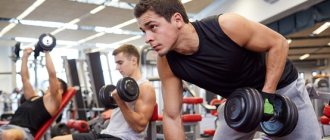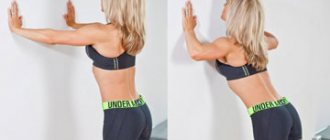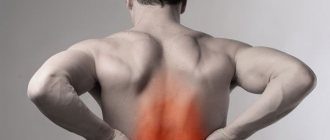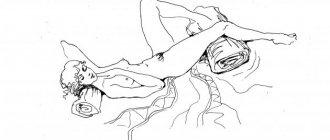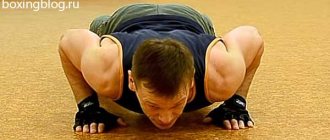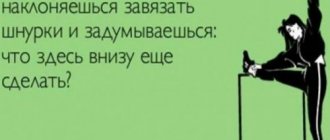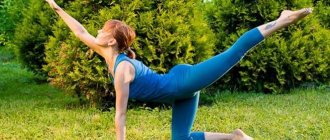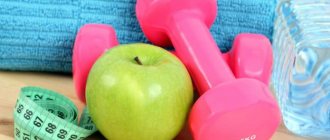In the technique, size/quarter push-ups are not a gymnastic, but an athletic exercise, which aims to build muscle tissue on the bones.
Muscle tissue grows best in the 6 to 12 rep range. But what if you can easily do 20 or more push-ups?
Then you need to move on to push-ups on one arm.
However, even people who can do two-armed push-ups 100 times in one set cannot always immediately do one-armed push-ups once, because one-armed push-ups are a completely different motor skill and require different motor coordination.
One-arm push-ups are mastered through lead-up exercises.
Create a push-up program for free
In many places on the Internet they write that it is better to master push-ups on one hand through push-ups with the support of the other hand.
However, this method does not give the body an understanding of how to maintain balance on three points. As practice has shown, people who learn to do one-arm push-ups from the sofa quickly understand how to do one-arm push-ups from the floor.
People who do not know how to do push-ups on two hands first learn to do push-ups from the wall, then from the table, then from the sofa, then from the floor.
Learning one-arm push-ups requires the same approach.
First you need to learn how to do push-ups on one hand from the wall, then from the table, then from the sofa and only then from the floor. One-arm push-ups are twice as hard as floor push-ups. It’s like asking a person who is used to bench pressing 50 kg to suddenly try doing a bench press of 100 kg. Methodologically this will be incorrect and very dangerous.
Typically, people who can do more than 20 push-ups can easily do one-arm push-ups on a table.
To progress to one-arm push-ups from the couch, you need to learn how to do 20 one-arm push-ups from the table.
To try doing one-arm push-ups from the floor, you must first learn how to do 20 one-arm push-ups from the couch.
A simple conclusion: if you can do push-ups from the floor more than 20 times, then you can move on to push-ups on one arm from the table; when you learn to do push-ups on one arm from the table 20 times, you can move on to push-ups on one arm from the sofa; and only after mastering 20 push-ups on one arm from the sofa, you can try doing push-ups on one arm from the floor.
What muscles work?
To understand the mechanism of correct execution of the exercise, you should first understand which muscles work when doing push-ups on one arm? In general, the same muscle groups that are involved in regular push-ups are included in the work:
- pectoralis major muscles;
- triceps;
- deltoid muscles;
- biceps;
- rectus and oblique abdominal muscles;
- serratus anterior muscles;
- gluteus maximus muscles;
- hamstrings;
- quadriceps;
- calf muscles;
- latissimus dorsi muscles.
The difference between the options is the accentuated load on certain muscle groups. In the “one-handed” version, the calves, hamstrings and quadriceps play a less important role. At the same time, the load on the lats increases significantly. Since one of the key points of support is lost, the body requires stabilizers to balance. In this context, the latissimus belongs specifically to the stabilizing muscles.
The role of certain muscles increases or decreases depending on the position of the body, arms, pelvis and legs. The closer the execution technique is to ideal, the greater the load on the triceps, deltoids, abs and stabilizers. The ideal technique is the one that requires the most effort. More about this in the appropriate section.
One-arm push-ups
The difference between push-ups on one hand from the floor is that instead of relying on two hands, and the setting can be on the palms, fists, fingers, wrists in both cases, you rely on only one hand.
There are also several varieties here, we will analyze them further. But first you need to understand one thing - learning to do push-ups this way is quite difficult. This includes roughly three stages:
- First, you learn to do push-ups well on both hands, using various techniques and gradually complicating the exercise . Mandatory here is the ability to do push-ups with weights, i.e. additional weight. Why? Because when doing push-ups with one arm, the load increases significantly, and the body must be prepared for this.
- Then you use adduction exercises - this is a transitional stage . They allow you to work on technique, prepare for one-arm push-ups, and gradually move directly to the push-ups themselves.
- And the third stage is one-arm push-ups . Here you can start with simpler variations and make them more complex.
What muscles are involved in one-arm push-ups?
Well, now we will find out what muscles work during such an exercise. When doing push-ups on two arms, the core muscles are actively involved in the work, namely the pectoral muscles, triceps, biceps and anterior deltoids. Statics work the lats, trapezius, abs and legs. One way or another, the whole body is involved in the push-up process and only benefits come from it.
When doing push-ups on one arm, the same muscles work as when doing push-ups on two arms, but they are loaded more heavily.
All the same muscles work when we talk about push-ups on one arm, but here the active muscles are loaded twice as much, since there is no second support. And muscles that work statically are forced to strain more in order to maintain balance and coordination of the body during push-ups.
What are the benefits of one-arm push-ups?
- They increase the athlete’s strength much faster due to the complexity of the exercise and increased stress on the muscles. Those, in turn, become stronger and grow faster.
- The exercise helps to involve more muscles in the work; in this case, the body and legs do not passively support the load, as with regular push-ups. They are much more tense to maintain their balance.
- Due to this instability of position and lack of support, muscle coordination and body balance are well trained.
Benefits and Benefits of Exercise
One-arm push-ups are an exercise that will make you much stronger and more resilient. Thanks in part to Paul Wade, author of The Training Zone, these movements became known as prison push-ups. Paul spent many years in prison, where he was able to develop enormous strength almost exclusively through bodyweight training. And push-ups played a major role in developing Wade's core strength.
Although the prisoner did not practice lifting weights, one day he became embroiled in a curious argument. The author of a motivational book was offered to speak at one of the powerlifting championships. In an effort to prove the superiority of the inventoryless system, Paul agreed to the bet. Without much experience with the barbell, he managed to take third place. This is the effect of powerful exercises designed for natural loading.
Strength growth
Regular push-ups quickly become a simple exercise that can be increased in intensity, mainly by increasing the number of repetitions. Eliminate one hand, and the load increases by an order of magnitude. Try to make the movement perfectly, and “physics” will add more order on top. Nobody can ever call people who can do push-ups on one arm weak. At least their feet have never crossed the threshold of the gym.
© takoburito — stock.adobe.com
Increased stamina
Over time, as physical capabilities increase, the same situation occurs as with the “classics”. The body adapts to the load and responds to training by increasing endurance. Athletes who are capable of repeated single push-ups have excellent body control and get much less tired under normal conditions than mere mortals.
Ability to work out anywhere
If a prisoner in solitary confinement has managed to become a titan of “physical education,” then complaints about the lack of suitable conditions look ridiculous and pathetic. The benefit of one-arm push-ups is that they can turn an untrained person into a role model in a matter of months.
Paul Wade went to prison at age 23. With a height of 183 cm, he weighed only 68 kg. It’s not easy in dungeons with such parameters. But, having begun to train intensively, within a year he was one of the strongest prisoners. Wade is not alone - his “colleagues” often surprise with their physical capabilities. His example and examples like him are indicative - they demonstrate the potential of bodyweight training. By the way, on our website in the crossfit exercises section you can find many exercises for working with your own weight.
Balance
Advanced push-ups require coordinated muscle action. Along with strength, the ability to control your body also grows. The body “learns” to work as a monolith - some groups are closely connected to others. An excellent example of a person who subordinated “physics” to consciousness is Bruce Lee. Little Dragon also did a lot of push-ups.
Bruce Lee's record for push-ups on one hand (on two fingers) is 50 times. Partly thanks to this, he became a “spring man,” ready and able to move to another position at any moment, like a cat.
Weight loss
Push-ups are an energy-intensive exercise. By regularly testing your body's strength, you can make rapid progress in losing weight. Now the plank has become fashionable - an effective abdominal exercise. But with push-ups, you're essentially doing the same plank in motion. Without support from the second hand, it is more difficult to do the exercise, and therefore the impact is higher.
Improved health
Regular one-arm push-ups help improve the functioning of the digestive system. Thanks to them, the heart is strengthened and the potential of the respiratory system increases. They have a beneficial effect on bones and ligaments - they become stronger.
Positive psychological impact
Few people can technically do push-ups on one arm. Agree, it’s nice to be part of a small group of athletes. You may be indifferent to the envy and admiration of others, but in any case you will have the right to be proud of yourself.
But it's not even a matter of pride or bragging. Transformation of the body's capabilities leads to increased self-esteem. The transition from one state to another is invariably accompanied by a positive psychological effect. Even seasoned weightlifters or powerlifters cannot perform this exercise. A tiny percentage of people can train with perfect technique. Isn't it nice to be in such company?
© undrey — stock.adobe.com
Benefits and harms
Of course, any physical activity (including push-ups) significantly improves the general condition of the body. Such exercises should be included in the outdoor switchgear complex because:
- the forearms are strengthened from the fingers to the elbow;
- joint flexibility develops;
- motor reactions of the hands improve;
- ligaments are strengthened, muscle elasticity increases;
- exercise is necessary to prevent inflammation of the joints (arthritis, bursitis);
- This is a kind of cardio workout.
The benefits of push-ups in general for the body:
- development of the muscles of the shoulder girdle and arms;
- strengthening the abdominal and lumbar muscles;
- due to blood flow to the ligaments and joints, the intensity of inflammatory processes is reduced;
- prevention and support of spinal therapy is carried out by strengthening the muscles of the back, chest and forearm.
Eastern medicine believes that there are many acupuncture points on the fingers.
By doing push-ups, a person affects most of them, thereby having a healing effect on the entire body as a whole, including internal organs. This improves health and improves well-being. Did you know? Push-ups are used to assess fitness and strength in branches of the Armed Forces, Police and Fire Services. They are also often included in screening and are a kind of assessment of muscle endurance.
Just like any sports, finger push-ups are not without contraindications. It is strictly contraindicated for people who:
- overweight;
- with excessive bone fragility;
- who have recently suffered a spinal injury and are in the rehabilitation period;
- with chronic diseases of the musculoskeletal system during exacerbation.
The joints may not be physically ready to handle the body weight, and injury cannot be avoided if you make the following mistakes:
- you perform the main exercise without warming up;
- you put stress on unprepared muscles;
- overtraining them.
Only that load is useful that is feasible for the body, develops and strengthens muscles. If you are unsure about your health or what exercise is right for you, consult a trainer.
Execution technique
There are many variations of this exercise. Some of them are designed for beginners, others are only suitable for advanced athletes. Let's consider the technique of the classic, most complex version. Starting from it, you can reduce the load - this allows you to master the movement gradually, regardless of your starting capabilities.
The standard option resembles regular push-ups. The visual difference is only in the “disabling” of one hand. No one can do it right away, no matter how much physical strength the athlete has. This requires special skills and “sharpening” of muscles and ligaments for this exercise.
Classic push-up
One-arm push-up technique:
- starting position - the body is in one line, the legs are shoulder-width apart or slightly narrower, the working hand is under the shoulder, the other hand is on the hip or behind the back; three support points: palm and toes;
- while inhaling, maintaining the starting line of the body and legs, lower to the level of your forehead touching the floor; strive for minimal body twisting and shoulder tilt - both help in mastering the exercise, but reduce the load;
- as you exhale, return to the starting position.
Reference option
Signs of reference performance:
- shoulders parallel to the floor;
- body twisting is minimal;
- legs no wider than shoulders;
- chest and head as close to the floor as possible;
- the pelvis is in line with the body.
Most people who are supposedly capable of such push-ups mislead others and themselves. By sacrificing a little ideal technique, you can make the execution much easier. Bend your pelvis slightly, help yourself with the shoulder of your passive arm, place your legs wide - it will be much easier to do push-ups. Such push-ups may delight the uninitiated, but why fool yourself?
Still, technical flaws can be considered such only in the context of ideal execution. Until you have fully mastered the exercise, you can and should sin. It won't work out any other way. To get the desired ability, you will need variations of the classic version.
Types of exercise
The described types of push-ups on one arm are designed to help you get to the standard performance. From a technical point of view, it is not necessary to use them all. It is enough to choose the right one and smoothly move towards the goal. But practice shows that variety in training leads to faster progress.
Push-ups with partial support on the second hand
You will need some kind of support - anything that is above the floor and convenient to use will do. Execution scheme:
- IP is similar to the classic one - with the difference that the free hand is moved to the side and rests on a block, ball or something else; in such a position, full support on the passive arm is impossible, but partial support is enough to ensure a noticeable reduction in the load;
- work, concentrating on the efforts of the working hand.
As you progress, focus more attention on the working side of the body, using the opposite side less and less.
Push-ups using the second hand
To make the exercise easier, you can do push-ups on both hands, but place one of them on the back side (the so-called L7 option). This will create an additional point of support, but in this position it is impossible to fully rely on the second hand. Inconveniences contribute to an automatic shift in focus to the work area. The execution scheme is similar.
Push-ups with hands above feet
Since school, we know that doing push-ups in a position where your arms are higher than your legs is easier. This scheme also works with single movements. Place your working hand on a bench, bed, or any other elevated position. Try to perform the exercise following the reference technique. Select suitable inclination angles, reducing them regularly.
There are other types of push-ups from the floor - the position of the hands and the execution patterns vary. Some of them are preparatory, others, on the contrary, complicate the task.
| Variation of push-ups | Nuances |
| Negative | The second hand is used during the lifting phase. In the negative phase (lowering), only one hand works. Obviously, this option is much easier than the full-fledged one. |
| With a jump | From the final position (arm bent, chest near the floor), the rise is made with a pushing movement. While helping your hand in the positive phase, in the negative phase you need to lower yourself carefully, with shock absorption, onto your slightly bent arm. You can begin this variation by being able to do several repetitions of regular “one-handed” push-ups. |
| Incomplete | The amplitude of movement is reduced. To fix the amplitude, you can place, for example, a ball under the chest. A good way to prepare the body for real stress. |
| With support on one leg | A complicated version of the usual one. You need to lift the leg opposite your working arm. An intermediate option involves a wide stance of the supporting leg and an extended free arm for balancing. |
| Supported by fingers, fist or back of hand | An already very difficult exercise can be made even more difficult by using weaker areas of the arm as support. |
Options for advanced
A more difficult level is finger push-ups. How to do it correctly? Having taken a classic stance, you need to lean on the fingers of your straight hand. If it doesn’t work out right away, it’s better to act gradually. For example, lean on your knees, so the load on your arms will be less. Or do regular push-ups, but in the process transfer the weight to your fingers by raising the backs of your hands. You can start simply with a fingerstand, gradually increasing the time. You should try again after a few days.
- Finger push-ups develop ligaments, strengthen your forearms, and make your fingers very strong. This is especially important when practicing martial arts.
Clapping push-ups look impressive - this is a plyometric exercise. From the usual starting position, lower yourself down. During the lifting, a jerk is made, when the body rises into the air, a clap of the hands is made, then the hands are put in place. This option is suitable for enhanced pumping of the chest, triceps, and shoulder muscles.
Only experienced athletes who have fully honed their technique and are ready for new heights can perform push-ups on one arm. This type of exercise develops the triceps, forearms and pectoral muscles. In this version, the legs should be placed wide to make it easier to maintain balance. One hand goes behind your back. The position of the torso should be slightly turned away from the support.
Contraindications and precautions
One-arm push-ups are not for beginners. The exercise requires a solid physical base and an understanding of technical nuances. There are few contraindications, but they exist. Doing push-ups without support on the other hand is not recommended for people who:
- have problems with the elbow, wrist and shoulder joints;
- suffer from heart disease; a large load on the body’s “engine” can lead to big problems, if there are prerequisites for this, a doctor’s consultation is necessary;
- suffered a muscle and/or ligament sprain.
Recommendations to help make the exercise as effective and safe as possible:
- move on to prison push-ups only after you are able to do two-arm push-ups at least 50 times; this preparation will be enough to safely enter the reduced movement;
- do not start trying to master the ideal technique of a full-fledged exercise until you have mastered the preparatory types at the proper level;
- strive for a variety of training - this will allow you to use various small muscles that do not work otherwise; as a result, you will progress faster;
- At the same time, strengthen the muscles involved with other exercises; It is recommended to place special emphasis on the abs and triceps;
- remember that the reference version is just one type of push-up; one must strive for it, but other varieties can be considered both preparatory and independent; “minor” options can be easily complicated, for example, by using weights; in addition, less complex variations can (or should) be performed “at times” - if in a full movement you are only capable of 1-2 repetitions, then the reduced ones will allow you to work on endurance;
- monitor the condition of the body; If you are very tired or in pain, you do not need to do push-ups.

